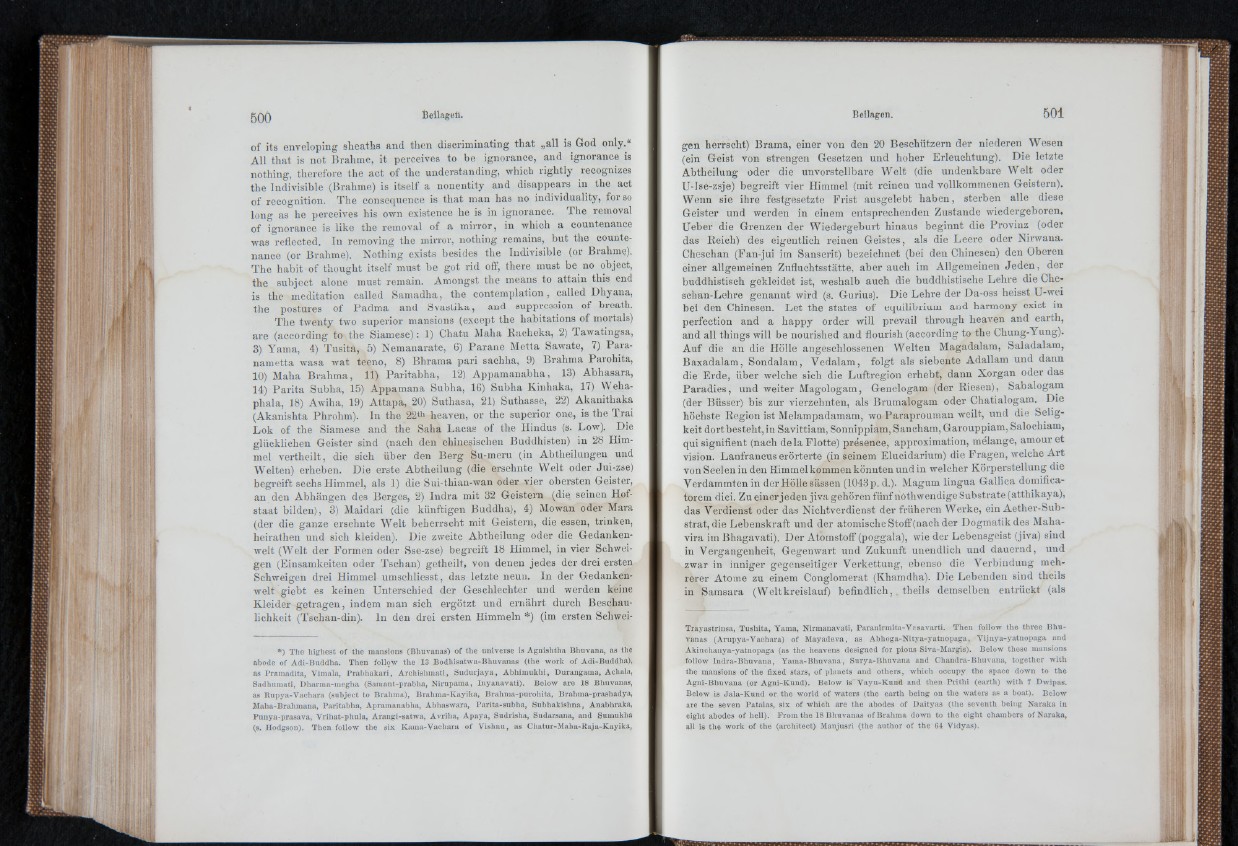
of its enveloping sheaths and then discriminating that „all is Grod only.tt
All that is not Brahme, it perceives to be ignorance, and ignorance is
nothing, therefore the act of the understanding, which rightly recognizes
the Indivisible (Brahme) is itself a nonentity and disappears in the act
of recognition. The consequence is that man has no individuality, for so
long as he perceives his own existence he is in ignorance. The removal
of ignorance is like the removal of a mirror, in which a countenance
was reflected. In removing the mirror, nothing remains, but the countenance
(or Brahme). Nothing exists besides the Indivisible (or Brahme).
The habit of thought itself must he got rid off, there must be no object,
the subject alone must remain. Amongst the means to attain this end
is the meditation called Samadha, the contemplation, called Dhyana,
the postures of Padma and Svastika, and suppression of breath.
The twenty two superior mansions (except the habitations of mortals)
are (according to the Siamese): 1) Chatu Maha Racheka, 2) Tawatingsa,
3) Yama, 4) Tusita, 5) Nemanarate, 6) Parane Metta Sawate, 7) Para-
nametta wasa wat teeno, 8) Bhrama pari sachha, 9) Brahma Parohita,
10) Maha Brahma, 11) Paritabha, 12) Appamanabha, 13) Abhasara,
14) Parita Subha, 15) Appamana Subha, 16) Subha Kinhaka, 17) Weha-
phala, 18) Awiha, 19) Attapa, 20) Suthasa, 21) Suthasse, 22) Akanithaka
(Akanishta Phrohm). In the 22th heaven, or the superior one, is the Trai
Lok of the Siamese and the Saha Lacas of the Hindus (s. Low). Die
glücklichen Geister sind (nach den chinesischen Buddhisten) in 28 Himmel
vertheilt, die sich über den Berg Su-meru (in Abtheilungen und
Welten) erheben. Die erste Abtheilung (die ersehnte Welt oder Jui-zse)
begreift sechs Himmel, als 1) die Sui-thian-wan oder vier obersten Geister,
an den Abhängen des Berges, 2) Indra mit 32 Geistern ..(die seinen Hofstaat
bilden), 3) Maidari (die künftigen Buddha), 4) Mowan oder Mara
(der die ganze ersehnte Welt beherrscht mit Geistern, die essen, trinken,
heirathen und sich kleiden). Die zweite Abtheilung oder die Gedankenwelt
(Welt der Formen oder Sse-zse) begreift 18 Himmel, in vier Schweigen
(Einsamkeiten oder Tschan) getheilt, von denen jedes der drei ersten
Schweigen drei Himmel umschliesst, das letzte neun. In der Gedankenwelt
giebt es keinen Unterschied der Geschlechter und werden keine
Kleider getragen, indem man sich ergötzt und ernährt durch Beschaulichkeit
(Tschan-din). ln den drei ersten Himmeln *) (im ersten Schwei*)
The highest of the mansions (Bhuvanas) of the universe is Agnishtha Bhuvana, as the
abode of Adi-Buddha. Then follow the 13 Bodhisatwa-Bhuvanas (the work of Adi-Buddha),
as Pramadita, Vimala, Prabhakari, Archishmati, Sudurjaya, Abhimukhi, Durangama, Achala,
Sadhamati, Dharma-megha (Samant-prabha, Nirupama, Inyanavati). Below are 18 Bhuvanas,
as Rupya-Vachara (subject to Brahma), Brahma-Kayika, Brahma-purohita, Brahma-prashadya,
Maha-Brahmana, Paritabha, Apramanabha, Abhaswara, Parita-subha, Subhakishna, Anabhraka,
Punya-prasava, Vrihat-phula, Arangi-satwa, Avriha, Apaya, Sudrisha, Sudarsana, and Sumukha
(s. Hodgson). Then follow the six Kama-Vachara of Vishnu, as Chatur-Maha-Raja-Kayika,
gen herrscht) Brama, einer von den 20 Beschützern der niederen Wesen
(ein Geist von strengen Gesetzen und hoher Erleuchtung). Die letzte
Abtheilung oder die unvorstellbare Welt (die undenkbare Welt oder
U-Isê-zsje) begreift vier Himmel (mit reinen und vollkommenen Geistern).
Wenn sie ihre festgesetzte Frist ausgelebt haben, sterben alle diese
Geister und werden in einem entsprechenden Zustande wiedergeboren.
Ueber die Grenzen der Wiedergeburt hinaus beginnt die Provinz (oder
das Reich) des eigentlich reinen Geistes, als die Leere oder Nirwana.
Cheschan (Fan-jui im Sanscrit) bezeichnet (bei den Chinesen) den Oberen
einer allgemeinen Zufluchtsstätte, aber auch im Allgemeinen Jeden, der
buddhistisch gekleidet ist, weshalb auch die buddhistische Lehre die Che-
schan-Lehre genannt wird (s. Gurius). Die Lehre der Da-oss heisst U-wei
bei den Chinesen. Let the states of equilibrium and harmony exist in
perfection and a happy order will prevail through heaven and earth,
and all things will be nourished and flourish (according to the Chung-Yung).
Auf die an die Hölle angeschlossenen Welten Magadalam, Saladalam,
Baxadalam, Sondalam, Vedalam, folgt als siebente Adallam und dann
die Erde, über welche sich die Luftregion erhebt, dann Xorgan oder das
Paradies, und weiter Magologam, Genelogam (der Riesen), Sabalogam
(der Büsser) bis zur vierzehnten, als Brumalogam oder Chatialogam. Die
höchste Region ist Melampadamam, wo Paraprouman weilt, und die Seligkeit
dortbesteht,in Savittiam, Sonnippiam, Sancham, Garouppiam, Salochiam,
qui signifient (nach de la Flotte) présence, approximation, mélange, amour et
vision. Lanfrancus erörterte (in seinem Elucidarium) die Fragen, welche Art
von Seelen in den Himmel kommen könnten und in welcher Körperstellung die
Verdammten in der Hölle sässen (1043 p. d.). Magum lingua Gallica domifica-
torem dici. Zu einer jeden jiva gehören fünf nòthwendige Substrate (atthikaya),
das Verdienst oder das Nichtverdienst der früheren Werke, ein Aether-Sub-
strat, die Lebenskraft und der atomische Stoff (nach der Dogmatik des Maha-
vira im Bhagavati). Der Atbmstoff (poggaia), wie der Lebensgeist (jiva) sind
in Vergangenheit, Gegenwart und Zukunft unendlich und dauernd, und
zwar in inniger gegenseitiger Verkettung, ebenso die Verbindung mehrerer
Atome zu einem Conglomérat (Khamdha). Die Lebenden sind theils
in Samsara (Weltkreislauft befindlich,. theils demselben entrückt (als
Trayastrinsa, Tushita, Yama, Nirmanavati, Paranirmita-Vasavarti. Then follow the three Bhuvanas
(Arupya-Vachara) of Mayadeva, as Abhoga-Nitya-yatnopaga, Vijnya-yatnopaga and
Akinchanya-yatnopaga (as the heavens designed for pious Siva-Margis). Below these mansions
follow In dr a-Bhuvana, Yama-Bhuvana, Surya-Bhuvana and Chandra-Bhuvana, together with
the mansions of the fixed stars, of planets and others, which occupy the space down to the
Agni-Bhuvana (or Agni-Kund). Below is'Vayu-Kund and then Prithi (earth) with 7 Dwipas.
Below is Jala-Kund or. the world of waters (the earth being on the waters as a boat). Below
are the seven Patalas, six of which are the abodes of Daityas (the seventh being Naraka in
eight abodes of hell). From the 18 Bhuvanas of Brahma down to the eight chambers of Naraka,
»11 is the work of the (architect) Manjusri (the author of the 64 Vidyas).